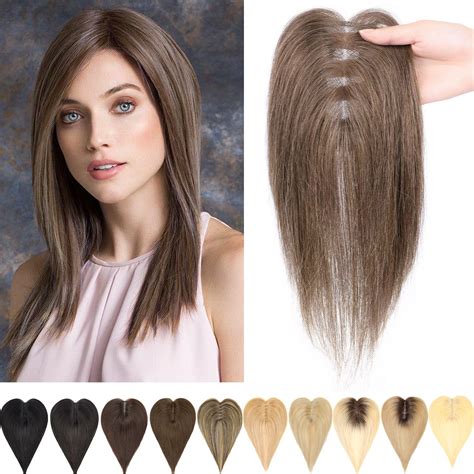Introduction
Hair loss affects millions of people worldwide, regardless of gender. While hair toppers have traditionally been associated with women, the market for men’s hair toppers is growing rapidly. Like women, men experience hair loss due to various factors, such as aging, genetics, and medical conditions. Hair toppers offer a discreet and convenient solution to conceal hair thinning or baldness.

Similarity to Men’s Hair Toppers
Women’s hair toppers share several similarities with their male counterparts:
-
Materials: Both women’s and men’s hair toppers are made from synthetic or human hair. They are designed to blend seamlessly with the wearer’s natural hair.
-
Base Construction: Toppers for both genders feature a base made of a breathable material, such as polyurethane or lace. This base allows the topper to be attached securely to the scalp without causing discomfort.
-
Attachment Methods: Women’s and men’s hair toppers can be attached using clips, glue, or tape. The choice of attachment method depends on the individual’s preference and scalp sensitivity.
Unique Considerations for Women
While women’s and men’s hair toppers share fundamental characteristics, there are some gender-specific considerations for women’s toppers:
-
Color and Texture: Women’s toppers come in a wider range of colors and textures to match the diverse hair types of women. They may feature subtle highlights or lowlights to create a natural-looking blend.
-
Length and Style: Women’s toppers are generally longer and offer more styling options compared to men’s toppers. They can be styled straight, curly, or in any other desired form.
Benefits of Hair Toppers for Men
Men’s hair toppers provide numerous benefits to combat hair loss:
-
Improved Confidence: Hair loss can significantly impact self-confidence. A topper can restore a man’s youthful appearance and boost his confidence.
-
Concealment: Toppers effectively conceal hair thinning or bald spots, enhancing the wearer’s overall appearance.
-
Non-Surgical Solution: Hair transplantation is a more invasive and expensive option compared to toppers. Toppers provide a less invasive and affordable solution to hair loss.
Strategies for Choosing a Hair Topper
Choosing the right hair topper requires careful consideration:
-
Hair Type: Determine your hair type and match it to the appropriate topper material (synthetic or human hair).
-
Base Size: Measure the area of hair loss to select a topper with a suitable base size.
-
Attachment Method: Choose an attachment method that is comfortable and secure for your scalp type.
-
Professional Consultation: Consider seeking professional advice from a hair replacement specialist to ensure the best fit and styling options.
Pros and Cons of Hair Toppers
Pros:
- Non-surgical and less invasive than hair transplantation
- Conceals hair loss effectively
- Boosts confidence and enhances appearance
- Variety of colors, textures, and styles to choose from
Cons:
- Requires maintenance and styling
- May be uncomfortable if not fitted properly
- Some toppers may be noticeable under certain lighting conditions
- Cost can be a factor
Table 1: Comparison of Women’s and Men’s Hair Toppers
| Feature | Women’s Toppers | Men’s Toppers |
|---|---|---|
| Color and Texture | Wider range of options, including highlights and lowlights | More limited range of colors, generally darker shades |
| Length and Style | Longer and offer more styling options | Shorter and less styling versatility |
| Market Growth | Steady growth due to increasing acceptance | Rapid growth due to increasing awareness and demand |
Table 2: Advantages and Disadvantages of Hair Toppers for Men
| Advantages | Disadvantages |
|---|---|
| Non-surgical solution | Requires maintenance and styling |
| Conceals hair loss effectively | May be uncomfortable if not fitted properly |
| Boosts confidence and appearance | Some toppers may be noticeable under certain lighting conditions |
| Affordable compared to hair transplantation | Cost can still be a factor |
Table 3: Tips for Choosing a Hair Topper
| Step | Description |
|---|---|
| Determine Hair Type | Match the topper material to your own hair type. |
| Measure Hair Loss | Determine the area of hair loss to select an appropriately sized topper. |
| Choose Attachment Method | Select a comfortable and secure attachment method for your scalp. |
| Seek Professional Advice | Consult a hair replacement specialist for expert guidance. |
Table 4: Effective Strategies for Styling Hair Toppers
| Strategy | Benefit |
|---|---|
| Use Hair Mousse | Adds volume and texture to the hair. |
| Blow-Dry with Brush | Gives the hair a more natural appearance. |
| Avoid Excessive Heat | Protect the hair from damage caused by heat styling tools. |
| Regular Maintenance | Wash and style the topper regularly to maintain its appearance. |
Conclusion
Women’s hair toppers have gained popularity as a solution for hair loss, while men’s hair toppers have emerged as an equally effective option for addressing male hair loss. By utilizing the same design principles as women’s toppers, men’s hair toppers offer a convenient, non-surgical, and confidence-boosting way to conceal hair thinning or baldness. As the demand for hair toppers continues to grow, research and development in this field will focus on creating even more natural-looking and customizable solutions for both men and women.
